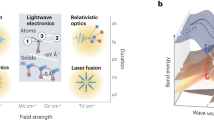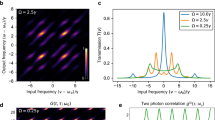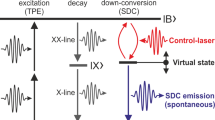Abstract
Coherent control of individual two-level systems is at the heart of any quantum information protocol. In solids1,2,3,4,5,6, two-level systems generated by bound electron–hole excitonic states, trapped in semiconductor quantum dots, display a robust coupling with light, enabling their optical manipulation via avant-garde approaches of nonlinear spectroscopy7,8. Here, we develop a novel toolbox for coherent control of a quantum dot exciton based on the nonlinear wave-mixing responses, which are enhanced by a photonic nanostructure. By employing three, short, resonant laser pulses, we show that we can manipulate, at will, the intrinsic coherence of the quantum dot dipole and therefore engineer the spectro-temporal shape of its coherent emission. Multi-pulse quantum control sequences, which have been successful in NMR spectroscopy and quantum computation9, can now be applied to optically active solid-state quantum bits with application in high-order nonlinear spectroscopy, ultrafast quantum optoelectronics and spread spectrum technology at the single emitter level.
This is a preview of subscription content, access via your institution
Access options
Subscribe to this journal
Receive 12 print issues and online access
$209.00 per year
only $17.42 per issue
Buy this article
- Purchase on Springer Link
- Instant access to full article PDF
Prices may be subject to local taxes which are calculated during checkout



 3.
3.
Similar content being viewed by others
References
Pla, J. J. et al. High-fidelity readout and control of a nuclear spin qubit in silicon. Nature 496, 334–338 (2013).
Muhonen, J. T. et al. Storing quantum information for 30 seconds in a nanoelectronic device. Nature Nanotech. 9, 986–991 (2014).
Widmann, M. et al. Coherent control of single spins in silicon carbide at room temperature. Nature Mater. 14, 164–168 (2015).
Yale, C. G. et al. All-optical control of a solid-state spin using coherent dark states. Proc. Natl Acad. Sci. USA 110, 7595–7600 (2013).
Carter, S. G. et al. Quantum control of a spin qubit coupled to a photonic crystal cavity. Nature Photon. 7, 329–334 (2013).
Hansom, J. et al. Environment-assisted quantum control of a solid-state spin via coherent dark states. Nature Phys. 10, 725–730 (2014).
Borri, P. et al. Ultralong dephasing time in InGaAs quantum dots. Phys. Rev. Lett. 87, 157401 (2001).
Langbein, W. & Patton, B. Heterodyne spectral interferometry for multidimensional nonlinear spectroscopy of individual quantum systems. Opt. Lett. 31, 1151–1153 (2006).
Vandersypen, L. M. K. & Chuang, I. L. NMR techniques for quantum control and computation. Rev. Mod. Phys. 76, 1037–1069 (2005).
Reithmaier, J. P. et al. Strong coupling in a single quantum dot–semiconductor microcavity system. Nature 432, 197–200 (2004).
Albert, F. et al. Microcavity controlled coupling of excitonic qubits. Nature Commun. 4, 1747 (2013).
Luxmoore, I. J. et al. Interfacing spins in an InGaAs quantum dot to a semiconductor waveguide circuit using emitted photons. Phys. Rev. Lett. 110, 037402 (2013).
Coles, R. J. et al. Waveguide-coupled photonic crystal cavity for quantum dot spin readout. Opt. Express 22, 2376–2385 (2014).
Reichert, T. et al. Highly directed emission from self-assembled quantum dots into guided modes in disordered photonic-crystal waveguides. Phys. Rev. B 90, 115310 (2014).
Arcari, M. et al. Near-unity coupling efficiency of a quantum emitter to a photonic crystal waveguide. Phys. Rev. Lett. 113, 093603 (2014).
Patton, B., Woggon, U. & Langbein, W. Coherent control and polarization readout of individual excitonic states. Phys. Rev. Lett. 95, 266401 (2005).
Kasprzak, J. et al. Up on the Jaynes–Cummings ladder of a quantum-dot/microcavity system. Nature Mater. 9, 304–308 (2010).
Kasprzak, J., Patton, B., Savona, V. & Langbein, W. Coherent coupling between distant excitons revealed by two-dimensional nonlinear hyperspectral imaging. Nature Photon. 5, 57–63 (2011).
Kasprzak, J. et al. Vectorial nonlinear coherent response of a strongly confined exciton–biexciton system. New J. Phys. 15, 055006 (2013).
Maier, S. et al. Bright single photon source based on self-aligned quantum dot–cavity systems. Opt. Express 22, 8136–8142 (2014).
Benny, Y. et al. Excitation spectroscopy of single quantum dots at tunable positive, neutral, and negative charge states. Phys. Rev. B 86, 085306 (2012).
Langbein, W. et al. Radiatively limited dephasing in InAs quantum dots. Phys. Rev. B 70, 033301 (2004).
Proux, R. et al. Measuring the photon coalescence time window in the continuous-wave regime for resonantly driven semiconductor quantum dots. Phys. Rev. Lett. 114, 067401 (2015).
Patton, B., Langbein, W., Woggon, U., Maingault, L. & Mariette, H. Time- and spectrally-resolved four-wave mixing in single CdTe/ZnTe quantum dots. Phys. Rev. B 73, 235354 (2006).
Bonadeo, N. H. et al. Coherent optical control of the quantum state of a single quantum dot. Science 282, 1473–1476 (1998).
Stievater, T. H. et al. Rabi oscillations of excitons in single quantum dots. Phys. Rev. Lett. 87, 133603 (2001).
Ramsay, A. et al. Phonon-induced Rabi-frequency renormalization of optically driven single InGaAs/GaAs quantum dots. Phys. Rev. Lett. 105, 177402 (2010).
Zhang, Y., Brown, A. W. & Xiao, M. Observation of interference between four-wave mixing and six-wave mixing. Opt. Lett. 32, 1120–1122 (2007).
Zhang, Y., Khadka, U., Anderson, B. & Xiao, M. Temporal and spatial interference between four-wave mixing and six-wave mixing channels. Phys. Rev. Lett. 102, 013601 (2009).
Turner, D. & Nelson, K. Coherent measurements of high-order electronic correlations in quantum wells. Nature 466, 1089–1092 (2010).
Axt, V. M., Bolton, S. R., Neukirch, U., Sham, L. J. & Chemla, D. S. Evidence of six-particle Coulomb correlations in six-wave-mixing signals from a semiconductor quantum well. Phys. Rev. B 63, 115303 (2001).
Voss, T. et al. Biexcitonic effects in the coherent control of the excitonic polarization detected in six-wave-mixing signals. Phys. Rev. B 66, 155301 (2002).
Moody, G. et al. Fifth-order nonlinear optical response of excitonic states in an InAs quantum dot ensemble measured with two-dimensional spectroscopy. Phys. Rev. B 87, 045313 (2013).
Tahara, H., Ogawa, Y., Minami, F., Akahane, K. & Sasaki, M. Long-time correlation in non-Markovian dephasing of an exciton–phonon system in InAs quantum dots. Phys. Rev. Lett. 112, 147404 (2014).
Minkov, M. & Savona, V. Radiative coupling of quantum dots in photonic crystal structures. Phys. Rev. B 87, 125306 (2013).
Acknowledgements
The authors acknowledge support from the European Research Council Starting Grant ‘PICSEN’ (contract no. 306387).
Author information
Authors and Affiliations
Contributions
F.F., Q.M. and J.K. carried out the experiments. F.F., Q.M. and J.K. performed the data analysis. F.F. conceived the idea of a multi-wave coherent control scheme and performed the theoretical modelling. J.K. designed and supervised the experiments. W.L. provided the analysis tool. G.N. and C.H. provided technical support. C.S., S.H. and M.K. fabricated the sample. F.F. and J.K. co-wrote the manuscript, with the participation of G.N. and W.L.
Corresponding authors
Ethics declarations
Competing interests
The authors declare no competing financial interests.
Supplementary information
Supplementary information
Supplementary information (PDF 2028 kb)
Rights and permissions
About this article
Cite this article
Fras, F., Mermillod, Q., Nogues, G. et al. Multi-wave coherent control of a solid-state single emitter. Nature Photon 10, 155–158 (2016). https://doi.org/10.1038/nphoton.2016.2
Received:
Accepted:
Published:
Issue Date:
DOI: https://doi.org/10.1038/nphoton.2016.2
This article is cited by
-
Extending the time of coherent optical response in ensemble of singly-charged InGaAs quantum dots
Communications Physics (2022)



